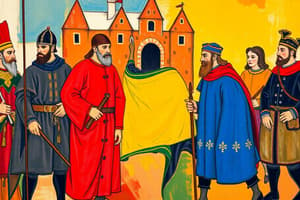Podcast
Questions and Answers
¿En qué se basaba el sistema feudal?
¿En qué se basaba el sistema feudal?
El sistema feudal se basaba en la tenencia de tierras.
¿Cómo se llamaba la relación entre el señor y el vasallo en el feudalismo?
¿Cómo se llamaba la relación entre el señor y el vasallo en el feudalismo?
La relación entre el señor y el vasallo se conocía como feudalismo.
¿Cuál era la jerarquía en el sistema feudal?
¿Cuál era la jerarquía en el sistema feudal?
La jerarquía en el sistema feudal incluía al rey o emperador en la cima, seguido de la nobleza, caballeros y campesinos o siervos.
¿Qué podían hacer los vasallos con las tierras que les habían sido concedidas?
¿Qué podían hacer los vasallos con las tierras que les habían sido concedidas?
¿Qué derechos tenían los señores en el sistema feudal?
¿Qué derechos tenían los señores en el sistema feudal?
¿Por qué se considera que el feudalismo ayudó a mantener la estabilidad social durante la Edad Media?
¿Por qué se considera que el feudalismo ayudó a mantener la estabilidad social durante la Edad Media?
¿Cuál era el objetivo principal de las Cruzadas?
¿Cuál era el objetivo principal de las Cruzadas?
¿Quién lideró la primera Cruzada en 1095?
¿Quién lideró la primera Cruzada en 1095?
¿Qué se les prometió a los cruzados de Europa occidental a cambio de su servicio militar en las Cruzadas?
¿Qué se les prometió a los cruzados de Europa occidental a cambio de su servicio militar en las Cruzadas?
¿Qué impacto tuvieron las Cruzadas en la Edad Media?
¿Qué impacto tuvieron las Cruzadas en la Edad Media?
¿Cómo ayudó el feudalismo a mantener el poder de la clase dominante durante la Edad Media?
¿Cómo ayudó el feudalismo a mantener el poder de la clase dominante durante la Edad Media?
¿Cuál fue la consecuencia negativa de las Cruzadas en relación con el Imperio Bizantino?
¿Cuál fue la consecuencia negativa de las Cruzadas en relación con el Imperio Bizantino?
Flashcards are hidden until you start studying
Study Notes
Edad Media: Feudalism and Crusades
The Middle Ages, also known as the Medieval period, spanned from the 5th to the 15th century. It was characterized by feudalism, a social and political system based on land tenure, and the Crusades, military campaigns sanctioned by the Catholic Church. This article will delve into these two significant aspects of the Middle Ages.
Feudalism
Feudalism was a social and political system based on land tenure, where lords granted land to vassals in exchange for military service or loyalty. The relationship between the lord and vassal was known as feudalism. The system was hierarchical, with the king or emperor at the top, followed by the nobility, knights, and finally the peasants or serfs.
The vassals, or knights, were bound to their lords and could not transfer their land to others. In return for their land, the vassals were required to provide military service and attend their lord's court. The vassals could also sublet their land to others, creating a chain of relationships between the lord, vassals, and other tenants.
Feudalism was a system of mutual obligations, with both the lords and vassals having rights and duties. The lords had the power to grant or revoke land grants and could demand services from their vassals. The vassals, on the other hand, had the right to use the land and could pass it on to their heirs.
Feudalism was a system that helped to ensure the stability of society during a time of political and social upheaval. It provided a sense of security and protection for the vassals, who were bound to their lords and could depend on their military support. It also helped to maintain the power of the ruling class and ensured that the military forces were organized and ready for battle.
Crusades
The Crusades were a series of military campaigns sanctioned by the Catholic Church from the 11th to the 13th century. The main objective of the Crusades was to capture the Holy Land, particularly Jerusalem, from the Muslims. The Crusades were also seen as a way to restore the Eastern Orthodox Church and to protect Christian pilgrims to the Holy Land.
The first Crusade, led by Pope Urban II in 1095, was a response to a plea for help from the Byzantine Emperor Alexius I. The Crusaders, who were mainly from Western Europe, were promised forgiveness of their sins and the promise of land in the Holy Land in exchange for their military service.
The Crusades were successful in capturing Jerusalem in 1099 and in establishing a number of Crusader states in the Holy Land. However, the Crusades also led to a decline in the power of the Byzantine Empire and the emergence of new states in the Middle East.
The Crusades had a significant impact on the Middle Ages, both politically and culturally. They helped to spread Christianity throughout Europe and the Mediterranean, and they also led to an increased trade and cultural exchange between the East and the West.
In conclusion, the Middle Ages were characterized by feudalism, a system of land tenure and mutual obligations, and the Crusades, military campaigns sanctioned by the Catholic Church to capture the Holy Land. These two aspects of the Middle Ages were interconnected, with the Crusades helping to maintain the power of the ruling class and feudalism providing a sense of security and protection for the vassals.
Studying That Suits You
Use AI to generate personalized quizzes and flashcards to suit your learning preferences.




